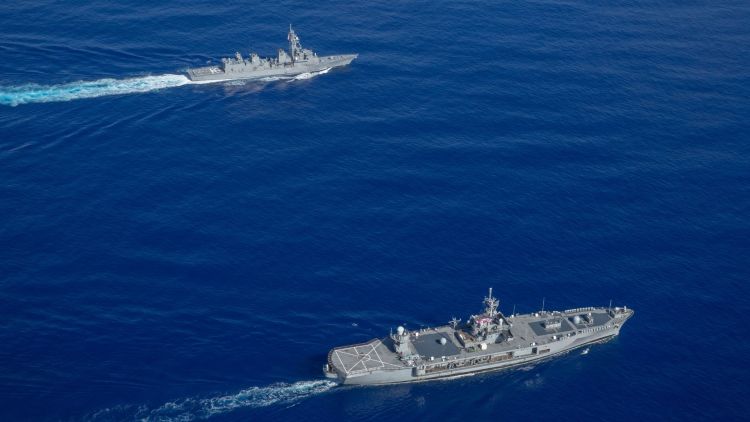Another week, another spike in tensions in the South China Sea. China is still pushing hard on its territorial claims in this critical and fiercely contested region.
As things heat up, the US and the Philippines are exploring tighter military cooperation to push back against Beijing’s aggressive moves.
The recent talk of American naval escorts for Philippine vessels hints at a big shift that could really shake up regional stability.
With China continuously testing its boundaries, the question of whether Uncle Sam should jump in with direct support is becoming more urgent, marking a pivotal moment in this ongoing dispute.
Here’s what we know about the latest updates on the matter.
The China-Philippines Standoff: What’s Happening?
Here’s a quick rundown: China is still not budging on its aggressive claims in the South China Sea, and now the Philippines is looking to its big brother, the US, for some backup.
If you’ve been keeping up with the Indo-Pacific, you’re probably familiar with the South China Sea as a hot spot for geopolitical tensions. Recently, things have gotten even more heated.
Chinese and Philippine ships have been clashing repeatedly, with everything from maritime blockades to direct collisions.
These run-ins, often involving Chinese coast guard and suspected militia vessels, have escalated to the point where Philippine ships delivering supplies to remote outposts are regularly harassed and blocked.
China’s aggressive tactics are all about pushing its sweeping territorial claims, often at the cost of neighbors like the Philippines.
The recent incidents, including blockades that have prevented Filipino ships from reaching their destinations, show the ongoing tussle and bustle for control over these disputed waters and the vital supply routes that run through them.
US Looks at Options to Help Philippine Ships in the Dispute
With tensions ramping up, Admiral Samuel Paparo, head of US Indo-Pacific Command, has reportedly hinted that the US military might step in to escort Philippine resupply missions in the South China Sea.
During a press conference in Manila on Tuesday (August 27), Paparo stressed that this kind of support would fall under the US-Philippines Mutual Defense Treaty, which means both countries are obligated to defend each other if attacked.
“Every option between the two sovereign nations in terms of our mutual defense, escort of one vessel to the other, is an entirely reasonable option within our Mutual Defense Treaty, among this close alliance between the two of us,” Paparo said, keeping things pretty vague.
The idea of US Navy ships escorting Filipino vessels is a pretty big move, showing just how worried Washington is about Beijing’s aggressive behavior.
At the end of the day, the region is a crucial waterway, not just for economic reasons but also for its broader geopolitical significance.
It also highlights Uncle Sam’s commitment to keeping the South China Sea open for navigation and pushing back against China’s growing influence.
With everything happening both at home and around the world, that’s the last thing we need right now.
Diplomatic Dilemmas: The US Role in the South China Sea
Even though there’s a strategic reason for potential US involvement, there are some big legal and diplomatic hurdles to think about.
For one, Philippine law doesn’t allow foreign military forces to directly engage in local combat, which puts a legal roadblock in front of US military escorts.
In addition, Philippine Armed Forces chief Gen. Romeo Brawner Jr. has hinted that he’d prefer Filipino forces to rely on themselves first, saying they’d explore all domestic options before asking for outside help.
“We are going to try all options, all avenues that are available to us in order for us to achieve the mission…in this case, the resupply and rotation of our troops,” Brawner told reporters at the same Tuesday conference.
“We will then seek for other options when we are already constrained from doing it ourselves.”
It just goes to show how complicated things are from the Philippines’ perspective—they’re trying to protect their sovereignty while still working closely with the US, all without making things worse with China.
As both countries navigate these turbulent waters, legal and diplomatic challenges are significant factors to consider when exploring closer US-Philippine cooperation.
China’s Thoughts on the Matter
It’s no surprise that China has reacted strongly to the idea of the US getting more involved in the South China Sea.
Chinese officials have repeatedly warned against any outside interference, insisting that the US has no right to step into regional disputes.
Beijing claims that its actions (justifying its aggressions to the T) in the South China Sea are completely legal and argues that Uncle Sam’s involvement would only make things more unstable.
This pushback is all part of China’s broader strategy to assert control over the South China Sea while keeping other powers out.
With its rapid military build-up and frequent run-ins with other countries in the region, China is making it clear that it wants to dominate these waters.
As the US and the Philippines explore closer cooperation, they must be mindful of how that could lead to increased Chinese aggression.
What’s Next for the South China Sea: Big Moves, Bigger Risks
Going back to the idea of US escorts for Philippine vessels in the South China Sea, this could clearly have big effects, serious repercussions for regional stability and international relations.
If the US and the Philippines team up more closely, other Southeast Asian countries with overlapping claims, like Vietnam, Malaysia, and Brunei, might also look to strengthen their ties with outside powers to balance China’s assertiveness.
This could push regional groups like ASEAN (short for the Association of Southeast Asian Nations) to take a stronger stand against China.
But there’s a downside, too: increasing tensions could risk a wider conflict involving major powers.
The back-and-forth between the US and China in the Indo-Pacific means that whatever happens in the South China Sea could end up shaking things up on a global scale.
—and again, that’s the last thing we need right now.
Crunch Time: How Will the US and Philippines Respond?
The South China Sea remains a hotspot of competing interests, often sparking conflicts between nations.
With China pushing hard on its territorial claims, the US and the Philippines are facing tough decisions on how to respond. The idea of US naval escorts for Philippine ships highlights just how urgent and tricky the situation is.
Finding the right balance between immediate defense needs and long-term regional stability will be key for both countries.
The choices they make in the coming months could have a big impact on the future of the South China Sea.
—
Disclaimer: SOFREP utilizes AI for image generation and article research. Occasionally, it’s like handing a chimpanzee the keys to your liquor cabinet. It’s not always perfect and if a mistake is made, we own up to it full stop. In a world where information comes at us in tidal waves, it is an important tool that helps us sift through the brass for live rounds.



